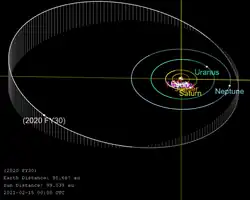 Orbit of 2020 FY30 | |
| Discovery [1][2] | |
|---|---|
| Discovered by | |
| Discovery site | Mauna Kea Obs. |
| Discovery date | 24 March 2020 (first imaged) |
| Designations | |
| 2020 FY30 | |
| Orbital characteristics[4] | |
| Epoch 27 March 2020 (JD 2458996.5) | |
| Uncertainty parameter 9 | |
| Observation arc | 0.82 yr (300 days) |
| Aphelion | 107.687±39.992 AU |
| Perihelion | 35.577±7.749 AU |
| 71.632±26.602 AU | |
| Eccentricity | 0.50333±0.29262 |
| 606.28±337.70 yr | |
| 238.823°±190.640° | |
| 0° 0m 5.853s / day | |
| Inclination | 13.858°±0.129° |
| 67.258°±0.375° | |
| 301.441°±71.686° | |
| Neptune MOID | ≈ 7.4 AU[2] |
| Physical characteristics | |
Mean diameter | 517 km (estimate) |
| 24.3[1] | |
2020 FY30 is a distant trans-Neptunian object that was discovered 100 AU (15 billion km) from the Sun by Scott Sheppard, David Tholen, and Chad Trujillo on 24 March 2020.[1] Announced on 14 February 2021, it is one of the most distant observable known objects in the Solar System.[4]
See also
References
- 1 2 3 "MPEC 2021-C282 : 2020 FY30". Minor Planet Electronic Circular. Minor Planet Center. 14 February 2021. Retrieved 15 February 2021.
- 1 2 3 4 "2020 FY30". Minor Planet Center. International Astronomical Union. Retrieved 15 February 2021.
- ↑ "List Of Centaurs and Scattered-Disk Objects". Minor Planet Center. Retrieved 14 February 2021.
- 1 2 3 4 "JPL Small-Body Database Browser: (2020 FY30)" (2021-01-18 last obs.). Jet Propulsion Laboratory. Retrieved 15 February 2021.
External links
- 2020 FY30 at the JPL Small-Body Database
- MPC
This article is issued from Wikipedia. The text is licensed under Creative Commons - Attribution - Sharealike. Additional terms may apply for the media files.